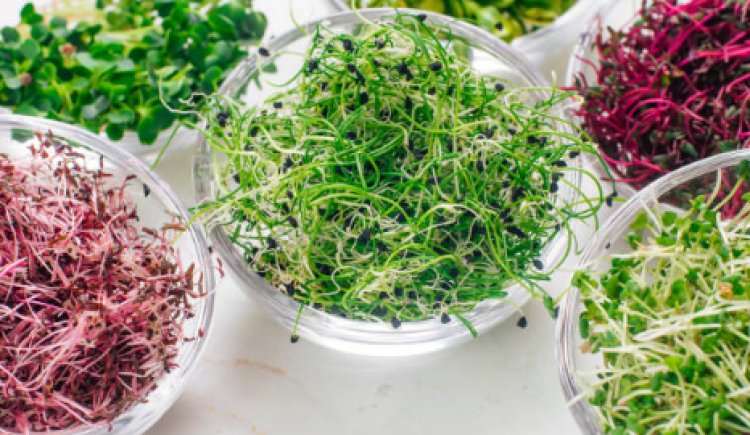8 Types of Microgreens to Grow In Your Home Garden
Microgreens are tiny, tender shoots of a vegetable or herb plant that are eaten before the first real leaves emerge, or at the cotyledon stage.

The majority of microgreens are grown to a height of between 5 and 10 cm. Microgreens can be mistaken for sprouts by those who are unfamiliar with them, however due to their growing process, they are extremely different from sprouts. Microgreens are suitable for harvesting ten to fourteen days after germination.
Microgreens are a significant source of nutrients. They are available in a variety of colors. Microgreens have the exact same flavor as ordinary greens, except they taste better.
Different types of microgreens;
Broccoli Microgreens

They taste mildly like broccoli and are earthy. Shallow pots can be used to grow broccoli microgreens seeds. Broccoli microgreens can be harvested in just 6 to 10 days after planting. They need soil that is both light and moist to flourish. When the broccoli microgreens are 2 to 3 inches tall, cut them just above the soil's surface and harvest them.
Broccoli microgreens offer added crunch to soups, sandwiches, and other dishes. Compared to the typical broccoli crowns we eat, they are far more nutrient-dense. In addition to being high in iron, calcium, and fiber, they are also high in vitamins A and C.
Sunflower Microgreens

The flavor of sunflower microgreens is described as nutty. They take only two weeks to mature and are simple to grow. Sunflower microgreen seeds can be easily grown in a tiny container, such as a recycled milk carton, a salad box, etc. During the growth process, choose a seeding mix soil and keep it moist. Sunflower microgreens also need adequate light and clean air to flourish. Consequently, as germination begins, open the lid.
Sunflower microgreens can be used in sandwiches, salads, soups, and dips. They can also be included in shakes and smoothies. Sunflower microgreens are a strong source of calcium and iron. The vitamins A, B, C, D, and E are all readily available through these microgreens. They are also easily digested in the body.
Cabbage Microgreens

Cabbage microgreen seeds need warm, moist soil to germinate; they also need adequate drainage and ventilation to thrive. Cabbage microgreens are ready for harvest when they have open, green leaves.
You can use cabbage microgreens as a garnish to soups, salads, and sandwiches. They are rich in nutrients, especially beta carotene, vitamin C, and vitamin E. They also have useful antioxidants in them.
Pak Choi Microgreens

Pak Choi or Chinese cabbage is a mild-flavored microgreen species that pairs well with soups and salads. You can obtain a batch of Pak Choi microgreens every 10 days with continuous planting. They can be grown in soil or hydroponic systems. Pak choi microgreen seeds must be covered for the first three days after sowing since they are light-sensitive. Use a sharp knife to cut directly at the stem when harvesting.
Beta-carotene, iron, vitamins C, K, and E are all abundant in pak choi microgreens. They can aid in preventing the development of cancerous cells as glucosinolate is present in them.
Radish microgreens

They are simple to grow and can be harvested as soon as ten days after planting. Growing radish microgreens from seeds is quite simple. Radish microgreens provides flavour, crunchy texture and a touch of spiciness to food. Radish microgreens are rich in the minerals and vitamins.
Corn Microgreens

Corn microgreens in partial light develop into lovely golden-yellow microgreens with a pleasant flavor. Additionally, they develop dark green leaves with a faint grassy and earthy flavor while being cultivated in full sun. These shoots have a distinctive sweetness similar to sweet corn. Corn microgreens help lower blood pressure, prevent anemia, strengthen bones, and increase the immune system.
Beetroot Microgreens

A variety of beetroot microgreens will provide color and nutrition to your microgreen garden. Beetroot microgreens have lovely pink, green, and red hues. They could require a couple of extra days to harvest compared to other microgreens. The roots of beetroot microgreen seeds prefer a small amount of water to thrive. As a result, check that your planting trays have adequate drainage.
The flavor of beetroot microgreens is similar to that of their mature beets, sweet and earthy. They may make excellent additions to salads, pastas, sandwiches, and soups. Iron, calcium, protein, and vitamins A, B, C, E, and K are all present in large quantities in beet microgreens. They also have plenty of copper, magnesium, and potassium.
Spinach Microgreens

Spinach microgreens are simple to grow with materials that are readily available in your own home. Water them frequently to promote growth, but take care to prevent the soil from becoming soggy. They work best in salads, soups, and sandwiches to provide extra flavor and crunch. They can also be used to garnish dishes.
Spinach microgreens are a rich source of vitamins A, C, K1, folic acid, calcium, iron, and magnesium. The nutritious content of the microgreens is way higher than that of the mature plant.


























